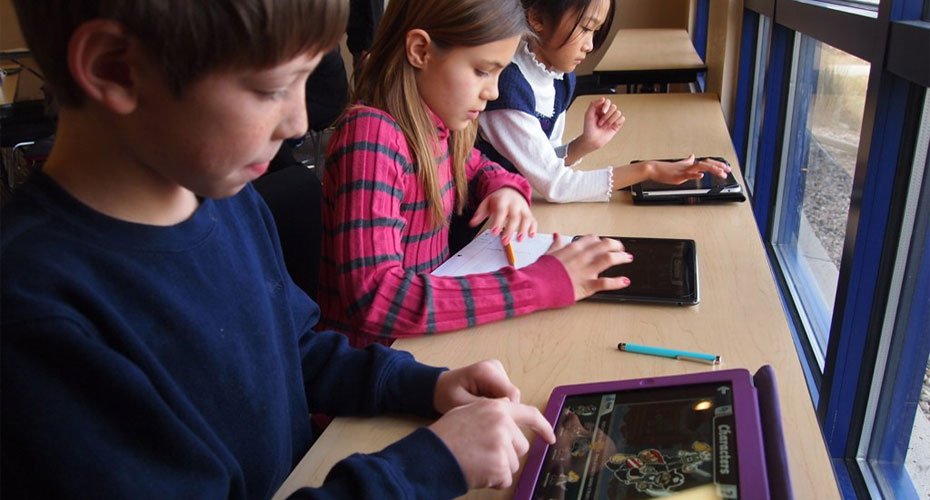Visit 4 Activity 7
Planning and drafting sections of stories
Context:
This lesson is the culmination of two weeks’ work. Previously, children worked with partners, to create an A3 paper story planner, using a series of boxes, and a map from the interactive story to describe their journey through the forest to Merlin’s hut. Children have access to the map in the interactive story, on their Chromebook. The children have annotated a separate paper version of the map with language to accurately describe their character’s journey through the bewitched forest.
The children have completed the ‘punctuating direct speech’ task from last week (transcribing from ChatterPix Kids and adding speech punctuation and reporting clauses) on paper.
The writing wall displays images from the story and children’s explanations of why they have chosen to include a character, based on its features and attributes. The working wall has key story vocabulary displayed in cursive script. In front of the writing wall is a washing line containing descriptions of Merlin’s Hut and Merlin.
The children are sitting with a Chromebook each, still exploring the interactive scene (the forest and merlin’s hut). The IWB has instructions for the lesson displayed:
- Log onto a Chromebook
- Finish off a storyboard
The children will write a story about the brave character who entered the bewitched forest and found Jakob and Maria.
Key activities
- Teacher recaps building a storyboard (from previous lesson)
- Children orally recount journey through the forest with their partner, using the storyboard
- Teacher models how to use a 7-stage planning template to plan each section of a story
- Children use their planning sheet to begin to draft each section of their story, making edits and improvements
- Children complete 7-stage story planners
- to plan each section of a story
- to use a planning sheet to begin to draft each section of a story
- Chromebook
- Interactive White Board
- The Bewitched Forest – Inspire Literacy
- Independent writing – with reference to previous activities
- Independent application of skills learned
- Story planning using a template and drawing on previous experiences and activities
- Story writing to develop ideas from template
- Do children enjoy relating ideas from the interactive scene and previous activities to their story planning?
- Do children engage with the use of the 7-stage planner, in relation to the interactive scene?
- Do children enjoy the storywriting activity?
- Are children engaged as storywriters?

Lesson Commentary
Introduction
The teacher recaps what the children were doing last week. She reminds them that with a partner they had created a storyboard using a visual from the interactive scene of the map of the story. The children had annotated a map and had then created a boxed storyboard that described their journey through the forest to Merlin’s hut.
- Children orchestrate a range of resources, including digital resources throughout this lesson, without appearing overwhelmed. The resources have been introduced over the previous two weeks.
- The digital resources have contributed to the children’s ongoing engagement with this story world and storywriting task
- Children shift role and focus to complete the planner, working across a large number of resources and modes
- Children are expected to adjust from first person composition (oral recount in role) to third person composition (to complete planner as narrator) as they move from digital resource to planner activity
- Children appear fully invested in the project. They are serious about their writing work
- The use of digital resources supports more traditional writing pedagogy (staged completion of planner for story structure and idea generation)
- The prior engagement in the full range of activities and resources (digital and more traditional) have blended over the past 11 days to build a storywriting world that the children appear to be occupying as writers; the use of digital resources works over time
- The children's process involves curation as part of the composition. They are selecting what to use, from the digital and non digital resources
- The teacher’s role switches from instructor and modeller to participant in the storywriting world, as she works alongside, as well as in front
- Extended time (over two weeks) is needed to build to the point where children can function independently as storywriters, having used a range of digital and non-digital resources
- Composing narrative with digital resources involves the construction of an holistic storywriting world that is complex and can involve resources and activities developed over time, and in a range of modes and formats
- Children will occupy different roles as a ‘writers’, as they build towards composing a definitive piece of narrative (collaborator, feedback giver and receiver, curator, solitary composer, actor in role, writer in role, story participant, story watcher, discoverer)
- The teacher will occupy different roles when working across digital and traditional resources to promote narrative writing
- Children will need to draw on explicitly taught skills-based knowledge, e.g. punctuating direct speech, which may be developed using traditional pedagogies for writing
- Digital resources and traditional resources/ activities can be blended to scaffold narrative writing
